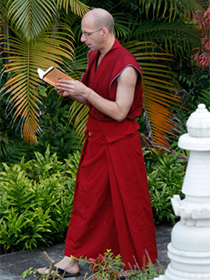- Home
- FPMT Homepage
Foundation for the Preservation of the Mahayana Tradition
The FPMT is an organization devoted to preserving and spreading Mahayana Buddhism worldwide by creating opportunities to listen, reflect, meditate, practice and actualize the unmistaken teachings of the Buddha and based on that experience spreading the Dharma to sentient beings. We provide integrated education through which people’s minds and hearts can be transformed into their highest potential for the benefit of others, inspired by an attitude of universal responsibility and service. We are committed to creating harmonious environments and helping all beings develop their full potential of infinite wisdom and compassion. Our organization is based on the Buddhist tradition of Lama Tsongkhapa of Tibet as taught to us by our founders Lama Thubten Yeshe and Lama Thubten Zopa Rinpoche.
- Willkommen
Die Stiftung zur Erhaltung der Mahayana Tradition (FPMT) ist eine Organisation, die sich weltweit für die Erhaltung und Verbreitung des Mahayana-Buddhismus einsetzt, indem sie Möglichkeiten schafft, den makellosen Lehren des Buddha zuzuhören, über sie zur reflektieren und zu meditieren und auf der Grundlage dieser Erfahrung das Dharma unter den Lebewesen zu verbreiten.
Wir bieten integrierte Schulungswege an, durch denen der Geist und das Herz der Menschen in ihr höchstes Potential verwandelt werden zum Wohl der anderen – inspiriert durch eine Haltung der universellen Verantwortung und dem Wunsch zu dienen. Wir haben uns verpflichtet, harmonische Umgebungen zu schaffen und allen Wesen zu helfen, ihr volles Potenzial unendlicher Weisheit und grenzenlosen Mitgefühls zu verwirklichen.
Unsere Organisation basiert auf der buddhistischen Tradition von Lama Tsongkhapa von Tibet, so wie sie uns von unseren Gründern Lama Thubten Yeshe und Lama Thubten Zopa Rinpoche gelehrt wird.
- Bienvenidos
La Fundación para la preservación de la tradición Mahayana (FPMT) es una organización que se dedica a preservar y difundir el budismo Mahayana en todo el mundo, creando oportunidades para escuchar, reflexionar, meditar, practicar y actualizar las enseñanzas inconfundibles de Buda y en base a esa experiencia difundir el Dharma a los seres.
Proporcionamos una educación integrada a través de la cual las mentes y los corazones de las personas se pueden transformar en su mayor potencial para el beneficio de los demás, inspirados por una actitud de responsabilidad y servicio universales. Estamos comprometidos a crear ambientes armoniosos y ayudar a todos los seres a desarrollar todo su potencial de infinita sabiduría y compasión.
Nuestra organización se basa en la tradición budista de Lama Tsongkhapa del Tíbet como nos lo enseñaron nuestros fundadores Lama Thubten Yeshe y Lama Zopa Rinpoche.
A continuación puede ver una lista de los centros y sus páginas web en su lengua preferida.
- Bienvenue
L’organisation de la FPMT a pour vocation la préservation et la diffusion du bouddhisme du mahayana dans le monde entier. Elle offre l’opportunité d’écouter, de réfléchir, de méditer, de pratiquer et de réaliser les enseignements excellents du Bouddha, pour ensuite transmettre le Dharma à tous les êtres. Nous proposons une formation intégrée grâce à laquelle le cœur et l’esprit de chacun peuvent accomplir leur potentiel le plus élevé pour le bien d’autrui, inspirés par le sens du service et une responsabilité universelle. Nous nous engageons à créer un environnement harmonieux et à aider tous les êtres à épanouir leur potentiel illimité de compassion et de sagesse. Notre organisation s’appuie sur la tradition guéloukpa de Lama Tsongkhapa du Tibet, telle qu’elle a été enseignée par nos fondateurs Lama Thoubtèn Yéshé et Lama Zopa Rinpoché.
Visitez le site de notre Editions Mahayana pour les traductions, conseils et nouvelles du Bureau international en français.
Voici une liste de centres et de leurs sites dans votre langue préférée
- Benvenuto
L’FPMT è un organizzazione il cui scopo è preservare e diffondere il Buddhismo Mahayana nel mondo, creando occasioni di ascolto, riflessione, meditazione e pratica dei perfetti insegnamenti del Buddha, al fine di attualizzare e diffondere il Dharma fra tutti gli esseri senzienti.
Offriamo un’educazione integrata, che può trasformare la mente e i cuori delle persone nel loro massimo potenziale, per il beneficio di tutti gli esseri, ispirati da un’attitudine di responsabilità universale e di servizio.
Il nostro obiettivo è quello di creare contesti armoniosi e aiutare tutti gli esseri a sviluppare in modo completo le proprie potenzialità di infinita saggezza e compassione.
La nostra organizzazione si basa sulla tradizione buddhista di Lama Tsongkhapa del Tibet, così come ci è stata insegnata dai nostri fondatori Lama Thubten Yeshe e Lama Zopa Rinpoche.
Di seguito potete trovare un elenco dei centri e dei loro siti nella lingua da voi prescelta.
- 欢迎 / 歡迎
简体中文
“护持大乘法脉基金会”( 英文简称:FPMT。全名:Foundation for the Preservation of the Mahayana Tradition) 是一个致力于护持和弘扬大乘佛法的国际佛教组织。我们提供听闻,思维,禅修,修行和实证佛陀无误教法的机会,以便让一切众生都能够享受佛法的指引和滋润。
我们全力创造和谐融洽的环境, 为人们提供解行并重的完整佛法教育,以便启发内在的环宇悲心及责任心,并开发内心所蕴藏的巨大潜能 — 无限的智慧与悲心 — 以便利益和服务一切有情。
FPMT的创办人是图腾耶喜喇嘛和喇嘛梭巴仁波切。我们所修习的是由两位上师所教导的,西藏喀巴大师的佛法传承。
繁體中文
護持大乘法脈基金會”( 英文簡稱:FPMT。全名:Found
ation for the Preservation of the Mahayana Tradition ) 是一個致力於護持和弘揚大乘佛法的國際佛教組織。我們提供聽聞, 思維,禪修,修行和實證佛陀無誤教法的機會,以便讓一切眾生都能 夠享受佛法的指引和滋潤。 我們全力創造和諧融洽的環境,
為人們提供解行並重的完整佛法教育,以便啟發內在的環宇悲心及責 任心,並開發內心所蘊藏的巨大潛能 — 無限的智慧與悲心 – – 以便利益和服務一切有情。 FPMT的創辦人是圖騰耶喜喇嘛和喇嘛梭巴仁波切。
我們所修習的是由兩位上師所教導的,西藏喀巴大師的佛法傳承。 察看道场信息:
- FPMT Homepage
- News/Media
-
- Study & Practice
-
-
- About FPMT Education Services
- Latest News
- Programs
- New to Buddhism?
- Buddhist Mind Science: Activating Your Potential
- Heart Advice for Death and Dying
- Discovering Buddhism
- Living in the Path
- Exploring Buddhism
- FPMT Basic Program
- FPMT Masters Program
- FPMT In-Depth Meditation Training
- Maitripa College
- Lotsawa Rinchen Zangpo Translator Program
- Universal Education for Compassion & Wisdom
- Online Learning Center
-
- Prayers & Practice Materials
- Overview of Prayers & Practices
- Full Catalogue of Prayers & Practice Materials
- Explore Popular Topics
- Benefiting Animals
- Chenrezig Resources
- Death & Dying Resources
- Lama Chopa (Guru Puja)
- Lama Zopa Rinpoche: Compendium of Precious Instructions
- Lama Zopa Rinpoche: Life Practice Advice
- Lama Zopa Rinpoche Practice Series
- Lamrim Resources
- Mantras
- Prayer Book Updates
- Purification Practices
- Sutras
- Thought Transformation (Lojong)
- Audio Materials
- Dharma Dates - Tibetan Calendar
- Translation Services
- Publishing Services
- Ways to Offer Support
- Prayers & Practice Materials
-
- Teachings and Advice
- Find Teachings and Advice
- Lama Zopa Rinpoche Advice Page
- Lama Zopa Rinpoche: Compendium of Precious Instructions
- Lama Zopa Rinpoche Video Teachings
- ༧སྐྱབས་རྗེ་བཟོད་པ་རིན་པོ་ཆེ་མཆོག་ནས་སྩལ་བའི་བཀའ་སློབ་བརྙན་འཕྲིན།
- Podcasts
- Lama Yeshe Wisdom Archive
- Buddhism FAQ
- Dharma for Young People
- Resources on Holy Objects
- Teachings and Advice
-
-
*If a menu item has a submenu clicking once will expand the menu clicking twice will open the page.
-
-
- Centers
-
- Teachers
-
- Projects
-
-
-
-
*If a menu item has a submenu clicking once will expand the menu clicking twice will open the page.
-
-
- FPMT
-
-
-
-
-
No anger inside means no enemy outside.
Lama Zopa Rinpoche
-
-
-
- Shop
-
-
-
The Foundation Store is FPMT’s online shop and features a vast selection of Buddhist study and practice materials written or recommended by our lineage gurus. These items include homestudy programs, prayers and practices in PDF or eBook format, materials for children, and other resources to support practitioners.
Items displayed in the shop are made available for Dharma practice and educational purposes, and never for the purpose of profiting from their sale. Please read FPMT Foundation Store Policy Regarding Dharma Items for more information.
-
-
Advice from Lama Zopa Rinpoche
6

Lama Zopa Rinpoche being led to the gompa at O.Sel.Ling Centro de Retiros by center director Anne Wenaas and Ven. Topgye, Spain, May 2019. Photo by Ven. Lobsang Sherab.
Lama Zopa Rinpoche wrote a benefactor thanking them for their support of a center and explaining a center’s benefits.
I just want to send you these cards and tell you that I highly appreciate your kindness in helping the center. The purpose of the center existing continually is to help sentient beings, and what sentient beings need most is to be free from the oceans of suffering, which is what they have been experiencing from beginningless rebirths. That means to be free from the oceans of samsaric suffering—the sufferings of rebirth, old age, sickness and death, and so forth. This is the suffering of pain. Then there is the suffering of change—all the samsaric pleasures, which cannot continue.
When we achieve enlightenment, that is when Dharma happiness is completed. The nature of samsaric pleasure is suffering. The suffering of pain and the suffering of change come from the third suffering, which is pervasive compounding suffering.
To be free from these three sufferings forever, we need to cease the cause of suffering—delusion and karma. For this we can’t have an operation in the hospital, or have it taken it out by a doctor or take tablets so it goes away. We can’t do that, it’s impossible. The only method is Dharma, the Buddha’s teachings. The centers are for that. That’s why the center is teaching Dharma, providing qualified teachers, translators, a place to practice, to hear the teachings and so many things.
This is a most urgent thing for sentient beings, more urgent than anything else. Not only that, through this it brings sentient beings to buddhahood, the total cessation of all the obscurations and completion of all realizations. Therefore, the need for the center to exist and to continue is of utmost importance for sentient beings.
By helping the center, you are helping all sentient beings, because then people come to learn Dharma at the center, and to practice bodhichitta, as they do the practice for all sentient beings, to benefit all sentient beings. That is how the center benefits numberless hell beings, numberless hungry ghosts, numberless animals, numberless human beings, numberless sura beings, numberless asura beings and numberless intermediate state beings.
From Lama Zopa Rinpoche’s advice “The Center is of Utmost Importance,” posted on the Lama Yeshe Wisdom Archive in December 2018:
https://www.lamayeshe.com/advice/center-utmost-importance
Watch Lama Zopa Rinpoche’s recent teachings in Madrid, Spain:
https://fpmt.org/media/streaming/teachings-of-lama-zopa-rinpoche/madrid_2019/
Lama Zopa Rinpoche is the spiritual director of the Foundation for the Preservation of Mahayana Tradition (FPMT), a Tibetan Buddhist organization dedicated to the transmission of the Mahayana Buddhist tradition and values worldwide through teaching, meditation and community service.
- Tagged: centers, lama zopa rinpoche
3
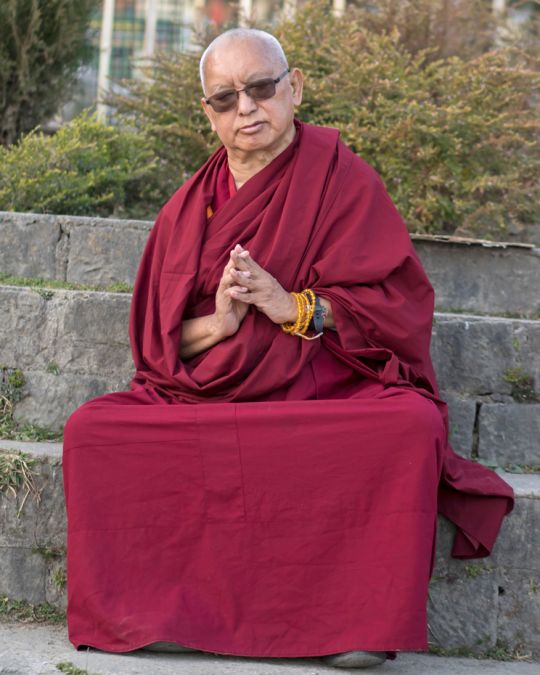
Lama Zopa Rinpoche making prayers at Tso Pema, India, January 2018. Photo by Ven. Lobsang Sherab.
Lama Zopa Rinpoche advised a student who wanted to help the sick and dying.
You don’t have to go [to the hospital] to help them; instead, wherever you stay, you can do the Eight Prayers to Benefit the Dead. Recite a different one, or two, each day, dedicated for them, for example, the “King of Prayers,” the “Prayer of the Virtuous Beginning, Middle and End,” the “Prayer to Be Reborn in Sukhavati,” Shantideva’s “Dedication Prayer,” and so forth. You can do that for them, as well as for every sentient being of the six realms.
Also, every OM MANI PADME HUM mantra you recite, or whatever mantras you do, such as Vajrayogini, you can do for every sentient being, including those who are sick and dying. That is helpful for them. Whatever you practice normally, do for others. Try to live your life for others—for every single sentient being, including every single insect, even the tiniest animals, and every single sura and asura. Whatever you do, try to help and dedicate it to everybody. That is very good.
Sometimes going to see people who are dying, if you don’t really know what helps them, then it can be that it doesn’t help and can even disturb their mind, causing attachment. Even if they regard it as good, actually it harms them by generating attachment. In the West people think attachment is very good, but they don’t know that generating attachment to the other person in reality is not helping but is harming.
Renunciation, bodhichitta, emptiness and correctly following virtuous friend [help those who are dying]. This is just talking from the side of sutra. This helps, otherwise it’s not so good. You have to know what is helping and what is harming. You have to know that. In the West, maybe the person is your enemy, but when that person is dying and you go to see them in hospital, if that person can’t speak, they may die with anger or attachment. So it harms them; it causes them to be reborn in the lower realms. I am using this as an example.
Anyway, for the time being it doesn’t come out to help those people who are dying and in the hospitals. What comes out best is to focus on your preliminary practices, retreats, and to do prayers for those people.
From Lama Zopa Rinpoche’s advice “How to Help People Who Are Sick and Dying,” posted on the Lama Yeshe Wisdom Archive website in December 2018:
https://www.lamayeshe.com/advice/how-help-people-who-are-sick-and-dying
For more advice from Rinpoche on death and dying, please visit our page “Death and Dying: Heart Practices and Advice”:
https://fpmt.org/death/
Lama Zopa Rinpoche is the spiritual director of the Foundation for the Preservation of Mahayana Tradition (FPMT), a Tibetan Buddhist organization dedicated to the transmission of the Mahayana Buddhist tradition and values worldwide through teaching, meditation and community service.
- Tagged: death and dying, lama zopa rinpoche
29
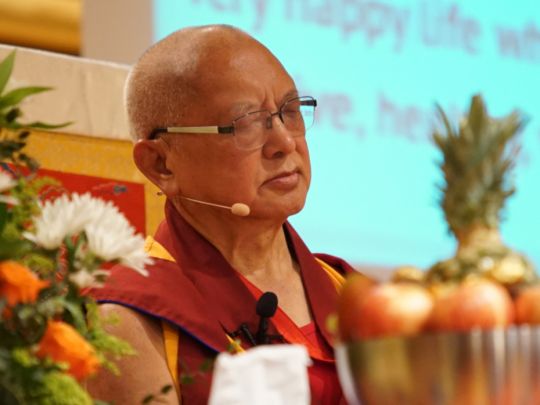
Lama Zopa Rinpoche in Madrid, Spain, April 2019. Photo by Alexis Roitmann.
Lama Zopa Rinpoche sent this letter to all the staff at an FPMT center, thanking them for working at the center.
My most dear, most kind, most precious, wish-fulfilling one,
My thanks, first of all, that you have taken a human rebirth, from many lifetimes practice, praying, and dedicating to receive a human body and especially a perfect human body, and now being able to practice the Dharma and meet the Mahayana teachings. From that, any practice you do always begins with bodhichitta.
The main purpose of one’s life is to free the numberless sentient beings in each realm from the oceans of samsara suffering and to bring them to Buddhahood—the peerless happiness. So therefore one needs to achieve Buddhahood in order to be able to do the perfect works for the sentient beings, without the slightest mistake.
Any Mahayana practice that you do begins with bodhichitta, to benefit all the sentient beings in the six realms. That means any practice you do with this motivation is helping the numberless sentient beings in every realm, that means every single hell being, hungry ghost, animal, human, sura, and asura in the numberless universes, so all the numberless sentient beings everyone.
The center you are at is not only helping people by giving them the opportunity to come to the center, but also by coming to the center then they find out about all the meditation subjects and the path to enlightenment.
By meeting Buddhism and finding out about meditation and the path to enlightenment, this is what helps them to purify past negative karma, to stop rebirths in the lower realms, by practicing morality, charity, and so forth. This creates the cause for higher rebirths in future lives, not even just for one lifetime. By practicing morality, keeping one precept, practicing charity, then this helps for so many hundreds and thousands of lifetimes. So it’s amazing, amazing the results.
In the Arya Sanghata Sutra the Buddha says, “The benefits of making charity to sentient beings, even the size of a single strand of hair, for eighty eons the result will be unbelievable wealth.”
Therefore in everyday life, practice charity with a healthy mind. I am saying this in a Western way, for those who don’t believe in reincarnation and karma. So then I say, a healthy mind, positive mind. So to practice with a mind without attachment, this is a peaceful mind. A mind with attachment is a disturbed mind, a contaminated mind, contaminated with suffering. So practice charity with a mind without attachment. Whether it is big or small charity, it is always helping, especially if it is to those in need, giving anything. So whatever you can give, this is the most important thing and this is creating a healthy life. From charity comes wealth and success in this life and next lives.
From pure morality, this leads to good rebirth, and being able to meet Dharma and to practice Dharma. Not only that, the next thing is be to free from samsara, by practicing the three higher trainings—the higher training of morality, the higher training of concentration, and the higher training of wisdom.
So now you can see by people coming to the center they learn how to be free from the oceans of samsara suffering. Not just for a few hours or a few days, but forever. Can you imagine?
So no matter how hard it is, it is so worthwhile because you are creating the cause for them to be free from death, free from suffering, free from birth, old age, and sickness, and so forth, to be free from the suffering of depression and dissatisfaction. Even the dissatisfaction of billionaires and zillionaires is worse than the suffering in the hell realms. Then there are the three kinds of suffering. There is the suffering of pain. Then, the suffering of change—which refers to all samsaric pleasures (such as the pleasures of music, surfing, jumping out of an airplane with a parachute, sex, drugs, alcohol, and so forth). All the samsara pleasures are in reality in the nature of suffering, but they appear as pleasure to begin with. This is what is called the suffering of change. Then the third suffering, the all-pervasive compounded suffering, is being under the contaminated seed of delusion and karma. So it is pervaded by karma, the seed. There is no worse suffering that the pervasive compounded suffering.
So to be free from all of this forever, this is by learning Buddhism, meditation, the three higher trainings, the five paths to liberation, and so forth. It is from this that one can know how to be free from samsara forever. Not only that, they meet the Mahayana teachings, learn bodhichitta on the basis of generating compassion to all sentient beings, practice the six paramitas, the sutra five paths and ten bhumis, and then they are able to meet the Mahayana tantra. And by practicing Mahayana tantra, they are able to achieve enlightenment in one brief lifetime of degenerate time.
It is by practicing the eight Mahayana precepts, or eight pratimoksha precepts, five lay vows, or even less than five, like four, three, two, or one, even just for one day, this is what helps for five hundred lifetimes to have a human rebirth or deva rebirth and so forth.
By practicing charity it brings the success of wealth and so forth, all the enjoyments, for many hundreds of lifetimes, or even thousands of lifetimes. This can come from even just one time giving charity. This is the real cause of success in your life.
Practicing the good heart is the most important thing and the best cause of success in your life. For however many times you are born in samsara, until you achieve the ultimate wisdom directly perceiving emptiness that ceases delusion and karma, which are the causes of the oceans of suffering in samsara, practicing the good heart is the real cause of happiness. Then there is no non-virtue, only virtue. The good heart is the best way to create virtue.
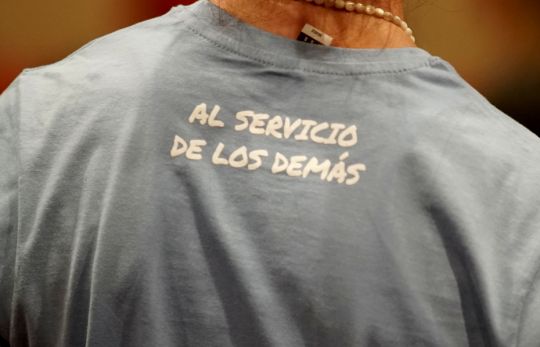
“In the service of others” is written in Spanish on the backs of t-shirts created for the Lama Zopa Rinpoche event in Spain, April 2019. Photo by Alexis Roitmann.
Of course people would think that it is from education. But there are so many uneducated people in the world, in less developed countries, who are so happy, whose wishes get fulfilled, who have wealth and all their wishes succeed, but they have no education. Education can help, but it is not the main cause; it is the condition. Many times, if you have education but don’t have a good heart, then having education causes problems such as ego, pride, non-virtuous thought, the thought to harm others and to destroy the world, and so forth.
Therefore some people have high degrees and very good education, but still they cannot find jobs, or it takes a long time. Of course if the person’s mind is open then I would suggest reading the Arya Sanghata Sutra and Golden Light Sutra in order to collect unbelievable merits and the causes of success. Then also my general advice is every day to help insects, people, animals, and especially those who have problems, to help them in any way possible.
So the ultimate conclusion is to practice the good heart. This is the best Dharma. With the good heart everything happens, especially enlightenment—the total cessation of all the obscurations and completion of all the realizations—not only to achieve enlightenment, but to free the numberless sentient beings from the oceans of samsara sufferings and to bring them to enlightenment.
So this is what you are doing and what the center does. All of you who are helping the center and working at the center, you are helping every sentient being, every animal, every ant in the differing universes, every mosquito, all the different kinds of fish, every slug, every mouse, every maggot, and every tiny flea.
Thank you very much. Please enjoy life with the good heart. That is the best way to enjoy the life. With a good heart, this causes inner happiness that goes up to enlightenment.
Thank you very much, see you soon.
With much love and prayers,
Lama Zopa
Colophon: Scribed by Holly Ansett, Taos, New Mexico, US, June 2017. Lightly edited by Laura Miller, March 2019.
Watch Lama Zopa Rinpoche teach live from Madrid, Spain, April 26-29:
https://fpmt.org/media/streaming/lama-zopa-rinpoche-live/
Find recordings of recent Lama Zopa Rinpoche teachings:
https://fpmt.org/media/streaming/teachings-of-lama-zopa-rinpoche/
Lama Zopa Rinpoche is the spiritual director of the Foundation for the Preservation of Mahayana Tradition (FPMT), a Tibetan Buddhist organization dedicated to the transmission of the Mahayana Buddhist tradition and values worldwide through teaching, meditation and community service.
26
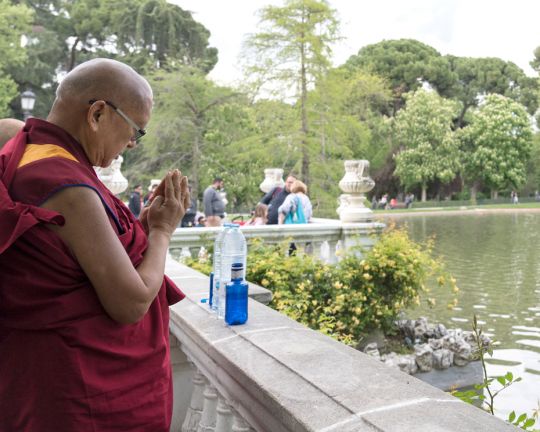
Lama Zopa Rinpoche blessing water to put in the lake and benefit all beings there, Madrid, Spain, April 2019. Photo by Ven. Lobsang Sherab.
A student wrote to Lama Zopa Rinpoche about how she and her brothers and sisters responded to the murder of their father and grandmother. Lama Zopa Rinpoche wrote back to the student and then requested that his letter and an edited version of the student’s original letter be shared online so that all could read them. Here is Rinpoche’s letter:
My most dear, most kind, most precious, wish-fulfilling one,
Thank you very much for your kind letter explaining your experience. Since you are a lawyer, what you would do normally, and what other people in the world would do normally, is only think of this lifetime, especially if someone had killed your father. That kind of harm is a huge and difficult one to bear.
Most people don’t think about karma, reincarnation, and so forth, and that all problems come from the mind, come from I. They don’t know that. Or even if they know intellectually, they don’t practice that. So they would put that person, whom they called “enemy,” in prison or they would kill that person, harm them back, or even do worse if they can. That is normally what people think and do in the world.
Then for a long time you were checking your experience and you realized that it is the result; you experienced the result of what you did in the past to others. The person who killed your father and grandmother were badly treated and harmed by you in the past.
Then you helped your brothers and sisters be harmonious and decide to help, instead of take revenge. This is the greatest practice. This is what Buddha said to do when somebody harms. This is what Buddha and what holy beings do in the world, and what bodhisattvas do. Somebody harmed you, worldly people say “an enemy,” but instead of harming back, you only benefit. This is what holy beings, bodhisattvas do, like that. Your actions follow that. This is the actual practice.
You made numberless gurus—His Holiness the Dalai Lama, all the gurus, all the buddhas, numberless bodhisattvas—most happy. You and your brothers and sisters made them most happy, pleased them the most. It is the best.
With my two hands together at my heart, I am thanking you a billion, zillion times from my heart to you and to your brothers and sisters. Please tell them I am thanking them. You pleased most His Holiness the Dalai Lama, the Buddha of Compassion, and then numberless buddhas and bodhisattvas.
The great bodhisattva Shantideva said in The Bodhisattva’s Way of Life:
My karma persuaded them,
Therefore, I received this harm.
Because of that, didn’t I make the person fall in the hole of the hell?
What it is saying is first why you received this harm. For example, relating to your life story, because you treated a person that way in a past life, the result happened: you received harm, and your father and grandmother were killed. By that action that happened, now the person who harmed is in the human realm, but soon that will end. That person will leave the human realm. And due to that negative karma, they will get born in the hole of the hell. Then suffer in the hell realms for an unbelievable, unbelievable, unbelievable length of time, suffer the heaviest suffering.
So that is not only practicing patience, but developing compassion, by thinking that the person who harmed you, which was due to your negative karma, now has to be born in hell and suffer for an unbelievable length of time. All that started originally from you; you harmed this person. This is a way to develop compassion—thinking about what obliged the person to do to harm, to engage in negative karma, to harm you. So please tell this to your sisters and brothers.
So in essence in Buddhism, first thinking only of your happiness, you see that to not receive harm from others, you don’t harm others. If you don’t harm others, then you don’t receive harm from others. If you benefit others, then as a result others benefit you, bring happiness to you. So that is only thinking of cherishing yourself, thinking only of you. So now thinking of numberless sentient beings, you stop harming others, then they don’t receive harm. The numberless sentient beings you benefit, they receive happiness. So this is incredible Mahayana Buddhism. This is the great vehicle, without talking about tantra. This is the basic practice of Mahayana Buddhism.
Similarly, the Tibetan people want to fight, like in the normal world, fight back at Mainland China, but His Holiness the Dalai Lama advised them to not fight. Without fighting the truth will win. He is talking only peace, in terms of dealing with Mainland China, only dealing in peace. If you fight, what happens is a similar story as you mentioned. Then you are creating the negative karma to receive harm from others, again and again. Then there is no end to suffering in samsara, no end, not only no beginning, but no end.
His Holiness the Dalai Lama advised that only by being peaceful, only by truth, will they win peace. It is so important this advice. This way you don’t receive harm back from others. You aren’t attacked by others. You don’t experience war. You get only the result—peace and happiness. You treat others peacefully, and as a result you receive peace, others help you. That is really Dharma practice.
Please tell your brothers and sisters, that is real practice, the best Dharma practice. What your family did, that should be an example to the world, to those who have highest scientific knowledge. Your family is a good example for all those billionaires and zillionaires. It is a good example for anyone—educated, uneducated, poor, rich. This is the best example for them.
Thank you very much.
With much love and prayers,
Lama Zopa
Here is the letter first sent by the student to Lama Zopa Rinpoche:
Dear Kyabje Lama Zopa Rinpoche,
… Five days after my ordination, my grandmother and father died in the same event. I felt shocked about losing my father. Just that day in the morning, he called me and asked me if I was happy with the ordination. He was Catholic, but respectful. I replied I was very happy. Then he replied he was happy for me too. Same day at night, he died with his mother in their house.
They were poisoned by gas in their house. The gas was coming from the kitchen, and they fell asleep and died. In time, we discovered they were killed. My father’s first cousin killed them in order to steal or inherit money and keep it from my family. When we discovered that, it was a great shock. I have two brothers and two sisters. We were very angry.
I was incredibly angry, very confused. Just being ordained, I was trying my best to have a good heart and good thoughts. On the other hand, I was very angry about what happened. Out of anger I decided to go and visit the person who killed my father. I took my purse and started to walk to the car. Suddenly an image of you, Rinpoche, came into my mind. You were sitting in meditation posture with a beautiful and exquisite smile. At that moment, I started to cry so deeply and I realized what had happened. Straight away I thought, “Only because of Rinpoche’s great compassion did he ordained me.”
Then I decided to not visit the person who damaged my family. I cried and cried for a couple of days, trying to put all the experience together. I just felt that ordination was protecting my mind from seeing (I was a lawyer before) revenge, killing, cheating, and stealing. Feeling so protected by you, feeling so, so fortunate, I made the following statement: “From now on, my aim and duty is going to be to reduce my anger. When I am capable of overcoming anger, then I will help my brothers and sisters.”
During many months I did analytical meditation about anger. After one year, the anger had been reduced very much. Then I started working with my brothers and sisters to reduce their anger. One day, continuing with analytical meditation, I thought, “Maybe that was family karma.” Then I thought, “If that is the case, that means that in the past we have created the same, killing and stealing an inheritance for our own family.”
I imagined killing my own family and stealing from them, and it was so difficult to believe. Because in this life I have not killed a human being. And I had the belief that I was a good person. I continued meditating and analyzing. And then I got an insight: “I cannot experience anything that I have not created.”
So I imagined again myself with my two brothers and two sisters killing someone’s father and stealing the inheritance. Oh, Rinpoche, the biggest pain I’ve ever experienced came, thinking and understanding that in a past life I had dared to kill someone, so painful. It’s very difficult to overcome that. By thinking about it over and over, after two years I felt some peace, to understand that we were experiencing the result of actions that we had created. If we created it, we deserved the result.
Then I thought, if we created it in another lifetime, in this life the best thing to do is not to put that person in jail but to offer the inheritance to the person who killed and stole from my family. After many meetings with my brothers and sisters, we decided to give away the money and properties from the inheritance to the cousin who killed and not to put her in prison. We decided peace in death was more important than inheritance, and peace in life was more important.
This story, Rinpoche, is to voice my huge gratitude to you. From the bottom of my heart, thank you so, so much Kyabje Lama Zopa Rinpoche for saving my life and protect my mind all the time. …
Colophon: Lama Zopa Rinpoche’s letter scribed by Ven. Holly Ansett, Nepal, March 2017. Both letters lightly edited by Laura Miller, March 2019.
Watch Lama Zopa Rinpoche teach live from Madrid, Spain, April 26-29:
https://fpmt.org/media/streaming/lama-zopa-rinpoche-live/
Find more advice from Lama Zopa Rinpoche:
https://fpmt.org/teachers/zopa/advice/
Lama Zopa Rinpoche is the spiritual director of the Foundation for the Preservation of Mahayana Tradition (FPMT), a Tibetan Buddhist organization dedicated to the transmission of the Mahayana Buddhist tradition and values worldwide through teaching, meditation and community service.
22
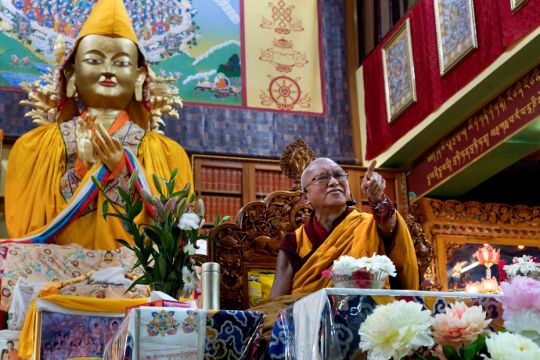
Lama Zopa Rinpoche teaching at Tushita Meditation Centre, McLeod Ganj, India, February 2019. Photo by Ven. Lobsang Sherab.
During the 2018 retreat in Australia, Lama Zopa Rinpoche gave advice on how to prepare for retreat, captured in this excerpt and video clip:
… I escaped [Tibet] through Bhutan to Buxa [Duar in India]. For eight years I lived in Buxa. Other monks lived there for ten years then went to Bylakuppe and Mundgod. I received teachings from my gurus and took part in debating. Of course my study was like that of a little child. My study was just child’s study, so nothing much.
So after coming back to Lawudo [in Nepal], reading the text of the Kadampa geshes’ advice on how to practice Dharma [Opening the Door of Dharma: The Initial Stage of Training the Mind in the Graduated Path to Enlightenment, a collection of advice by Lodro Gyaltsen] I checked back over my life.
All those lives I checked back, which become Dharma or not, what became Dharma or not, what I did and whether it became Dharma or not. When I looked back by reading that text, nothing became Dharma. All those things I did didn’t become Dharma. I realized that nothing became Dharma.
Then because of that I was able to clean my mind like you clean the room, like you clean the house of garbage—it makes the house dirty so you clean it out. I was able to clean my mind by reading that.
Then I began the Vajrayogini retreat, my first time. So because of that, it was unbelievable, incredible, hard to believe the first day, hard to believe that if my life could be like this, my whole life could be like this. I couldn’t believe, incredible peace and happiness, peace was incredible, unbelievable, couldn’t believe the whole life could be like that. The retreat became really very pure because of having read that text and cleaned out the garbage of the mind.
So the garbage is the eight worldly dharmas. This is an idea for you, if you want to do retreat, the best thing is to read this text. I gave teachings in Bodhgaya so there is book, what is it called?
Student: The Door to Satisfaction.
Rinpoche: It is not completely translated from the Tibetan text, most has been, but not completely translated. So to read that before doing retreat, my experience is to clean your mind first then you begin tantra retreat, then it becomes clean, very pure. Then you taste the Dharma, your mind becomes Dharma. …
Watch more of Lama Zopa Rinpoche teaching on “Why to Abandon the Eight Worldly Dharmas, How to Prepare for Retreat”:
https://youtu.be/uJzPi45Rc-U
Colophon: Excerpted from Lama Zopa Rinpoche’s teachings at the Great Stupa of Universal Compassion, Bendigo, Victoria, Australia, April 8, 2018. Simultaneously transcribed by Ven. Joan Nicell. Lightly edited by Laura Miller, February 2019.
Find complete videos of Lama Zopa Rinpoche’s recent teachings:
https://fpmt.org/media/streaming/teachings-of-lama-zopa-rinpoche/
Rinpoche teaches in Spain, April 26-29, then leads a Vajrayogini retreat at Institut Vajra Yogini in France, beginning May 10. Public teachings from these events will be streamed live:
https://fpmt.org/media/streaming/lama-zopa-rinpoche-live/
Lama Zopa Rinpoche is the spiritual director of the Foundation for the Preservation of Mahayana Tradition (FPMT), a Tibetan Buddhist organization dedicated to the transmission of the Mahayana Buddhist tradition and values worldwide through teaching, meditation and community service.
- Tagged: essential extract, lama zopa rinpoche, retreat, video
12
Advice for Merit Multiplying Days
Lama Zopa Rinpoche gave advice regarding merit multiplying days such as the Fifteen Days of Miracles, Saka Dawa, Chokhor Duchen, and Lhabab Duchen. The next merit multiplying day is Saka Dawa on June 17, 2019.
On the day of Guru Shakyamuni Buddha’s turning the Wheel of Dharma, if you do one prostration while reciting the names of the Thirty-Five Buddhas, it becomes equal to having done 100 million prostrations while reciting the names of the Thirty-Five Buddhas. If you recite one Vajrasattva mantra, it becomes the same as having done the Vajrasattva mantra 100 million times. If you recite the Diamond Cutter Sutra (Vajra Cutter Sutra) one time, it becomes the same as having recited the Diamond Cutter Sutra 100 million times—so that much purification and you collect that many merits to quickly be free from samsara, and if the practices are done with bodhichitta, then to quickly achieve enlightenment.
Reading the Golden Light Sutra (Sutra of Golden Light), besides the personal benefits that creates, also brings so much peace in the world, for the Buddhadharma to last a long time, which means more sentient beings being able to meet the Dharma and to achieve enlightenment. Then, also reciting the Arya Sanghata Sutra, which brings success, including enlightenment. Each recitation becomes 100 million recitations—so please tell your parents and friends this.
This is the best way to help your parents and this really helps your parents. You can tell others this also and their friends. This really helps the world, to make a better world.
Please read my notes well. Don’t rush. Think about each word.
Also on these days, you can do tonglen—taking others sufferings and giving away one’s own happiness—then, also rejoicing. You can meditate on dependent arising (meaning, emptiness only) and develop bodhichitta. Of course, you can do self-initiation during this very special time according to the time in India.
If you want to know which lama and which text mentioned this, it was His Holiness the Dalai Lama’s and His Eminence Sakya Trizin’s guru—Chobgye Trichen Rinpoche. Rinpoche referred to Guru Shakyamuni Buddha’s teaching Dulwa Lung (‘dul ba lung) as saying that the number the merit multiplies by is 100 million. It is a great advantage to practice during these times; like for myself, who is the most extremely laziest person in this world.
Another very important practice to do on these days is taking the eight Mahayana precepts for one day until the next day at sunrise. That doesn’t mean necessarily until sunrise Indian time. It means sunrise at the place where you are; up until dawn, when the sun rises in your part of the world.
In case there are difficulties to keeping all eight precepts, perhaps due to work, for example, you can take the rest of the vows well. Taking the eight Mahayana precepts is so beneficial for world peace, for crops to grow well, to receive timely rains—all this is needed to make the world better. Then, there are incredible benefits for yourself. This is explained in the book of the eight Mahayana precepts. This is so important for your own life to be better and to make the world better, to bring benefit.
Written by Lama Zopa Rinpoche, August 2017, United States. Edited by Michael D. Jolliffe for publication on FPMT.org.
Lama Zopa Rinpoche is the spiritual director of the Foundation for the Preservation of Mahayana Tradition (FPMT), a Tibetan Buddhist organization dedicated to the transmission of the Mahayana Buddhist tradition and values worldwide through teaching, meditation, and community service.
- Tagged: buddha day, merit multiplying day
11
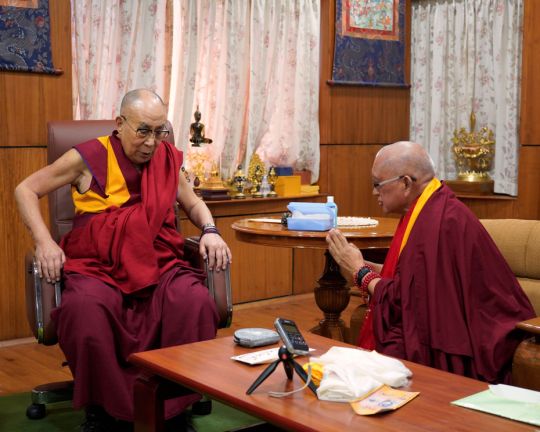
His Holiness the Dalai Lama with Lama Zopa Rinpoche during a presentation on the activities of FPMT, Dharamsala, India, August 2018. Photo courtesy of the Office of His Holiness the Dalai Lama.
Earlier this week His Holiness the Dalai Lama was admitted to hospital in New Delhi, India, suffering from what seems to be a chest infection.
Tenzin Osel Hita, the recognized reincarnation of FPMT co-founder Lama Yeshe, sent a message to Lama Zopa Rinpoche, FPMT co-founder and spiritual director, asking if prayers or pujas could be done by all the FPMT centers for His Holiness, with some suggested practices.
Lama Zopa Rinpoche checked and is advising all FPMT centers, projects, and services to please make tsog offerings, requesting for His Holiness’s long life and for His Holiness to be free of the present illness, and also to make tsog offerings to purify our own degenerated vows and samaya, and to hook realizations.
In addition, Rinpoche advises to please liberate animals.

His Holiness the Dalai Lama with Lama Zopa Rinpoche, Dharamsala, India, August 2018. Photo courtesy of the Office of His Holiness the Dalai Lama.
Find Rinpoche’s advice Liberating Animals from the Danger of Death here:
https://fpmt.org/wp-content/uploads/teachers/zopa/advice/pdf/liberating_animals_c5.pdf
The FPMT Foundation Store also offers the Animal Liberation Tools:
https://shop.fpmt.org/Animal-Liberation-Tools-PDF_p_3166.html
Lama Zopa Rinpoche is the spiritual director of the Foundation for the Preservation of Mahayana Tradition (FPMT), a Tibetan Buddhist organization dedicated to the transmission of the Mahayana Buddhist tradition and values worldwide through teaching, meditation and community service.
8
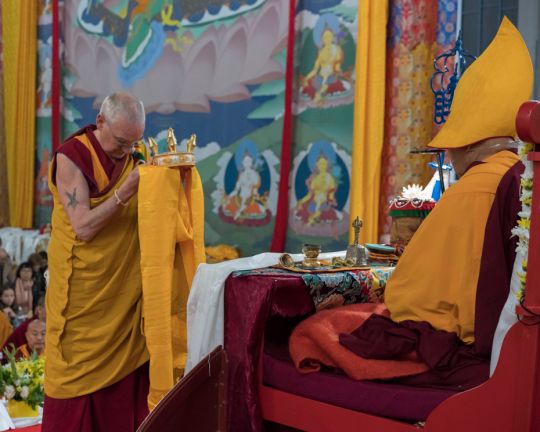
Ven. Roger Kunsang offering a mandala to Lama Zopa Rinpoche during the long life puja concluding the retreat at the Great Stupa of Universal Compassion, Australia, May 2018. Photo by Ven. Lobsang Sherab.
During the 2018 retreat at the Great Stupa of Universal Compassion in Australia, Lama Zopa Rinpoche taught extensively on guru devotion. In the following, Rinpoche shares examples of quotes on guru devotion and concludes the half-hour video clip with a discussion of the proper motivation for listening to teachings.
In the tantric text Yeshe Gyatso, Oceans of Transcendental Wisdom, it says:
YÖN TEN THAM CHÄ RAB DZOG KYANG
Even if all qualities are completed,
LA MA ME PÄ SI THAR MIN
Without a guru you cannot be liberated from samsara.
“Even if all the qualities are completed, but without a guru you can’t be liberated from samsara.” So even if you know by heart all the Kangyur and Tengyur, you can explain them by heart, but without a guru .…
It is possible that many people who don’t know lamrim—who don’t know the essence of Dharma, lamrim, how to actualize the path to enlightenment, who do not know—would think like this. I think in particular many Westerners might think like that. They don’t understand about the guru. There are many people who think like that: you can do it without a guru.
There it says in the tantric text:
YÖN TEN THAM CHÄ RAB DZOG KYANG
Even if all qualities are completed,
LA MA ME PÄ SI THAR MIN
Without a guru you cannot be liberated from samsara.
There is a quote from Array of Stalks Sutra:
KYA WA DZIN PA ME PAR NI
Without the oarsman,
DRU YI PHA RÖL CHIN MI NÜ
A boat cannot cross the river.
LA MA ME PÄI GONG RÖL NA
Before the guru
SANG GYÄ ZHE JÄI MING YANG ME
There is not even the name “buddha.”
KYA WA, the wood [oar]; KYA WA DZIN PA ME PA is “without a captain, the one holding that [oar].” “Without a captain, the boat alone cannot cross a river.” “Without an oarsman, the boat cannot cross the river.” You understand? That example is given.
LA MA ME PÄI GONG RÖL NA / SANG GYÄ ZHE JÄI MING YANG ME: “Before the guru, there is no buddha, there is no name even ‘buddha.’” All the buddhas come from the guru. This is what the Buddha’s quotation shows.
Therefore, one must cherish—hold on to the guru as more precious, more kind than the buddhas, than the ten-direction buddhas, the three-time buddhas, the numberless past, present, and future buddhas, all the numberless buddhas.
The practice is—it is not praising myself because I am called guru, I’m not praising myself—but how we should practice. I’m talking about that. So therefore, the most important mindful practice, meditation, is correctly following the virtuous friend with thought and action, not just devotion, only one thing, leaving out all the actions—with thought and action, you have to remember that, the nine attitudes, all those actions you have to understand. …
Watch the teaching by Lama Zopa Rinpoche from which the above excerpt is taken:
https://youtu.be/H2ViliSrTX0
Colophon: Excerpted from Lama Zopa Rinpoche’s teachings at the Great Stupa of Universal Compassion, Bendigo, Victoria, Australia, April 6, 2018. Simultaneously transcribed by Ven. Joan Nicell. Lightly edited by Laura Miller, March 2019.
Find complete videos of Lama Zopa Rinpoche’s recent teachings:
https://fpmt.org/media/streaming/teachings-of-lama-zopa-rinpoche/
Lama Zopa Rinpoche is the spiritual director of the Foundation for the Preservation of Mahayana Tradition (FPMT), a Tibetan Buddhist organization dedicated to the transmission of the Mahayana Buddhist tradition and values worldwide through teaching, meditation and community service.
- Tagged: essential extract, guru, guru devotion, lama zopa rinpoche, practice, video
5
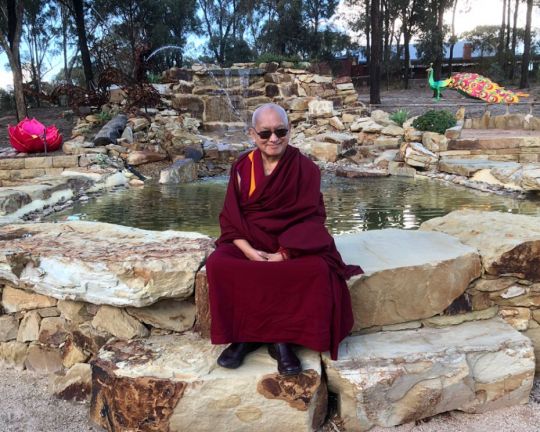
Lama Zopa Rinpoche in the Peace Park at the Great Stupa of Universal Compassion, Bendigo, Australia, May 2018. Photo by Ven. Roger Kunsang.
The FPMT Annual Review 2018 featured a letter from Lama Zopa Rinpoche, advising on the benefits of serving the guru. Here’s an excerpt from Rinpoche’s letter:
My most dear, most kind, most precious, wish-fulfilling ones,
From the bottom of my heart, thank you all numberless times for all your service, dedication, practice of holy Dharma with your body, speech, and mind, and for your devotion and good heart.
Here I wanted to give you this advice:
Lama Tsongkhapa said:
By correctly serving the guru, the virtuous friend,
The karma one has to experience in the evil gone realms,
Instead one experiences as a small harm to the body and mind in this life,
Or even in a dream and in this way the karma finishes.
This means that the heavy karma that otherwise would have resulted in you being born in the lower realms, for so many eons, it all gets finished by serving the guru.
Also it is mentioned in Kshitigarbha Sutra:
By correctly following the virtuous friend,
The karma to wander in the evil gone realms for an unfathomable amount of time (ten million eons),
As well as in this life to experience harm to the body and mind,
Such as epidemics, contagious disease, famines, and so forth,
All this gets totally purified by receiving a scolding, being teased, or even just having a dream.
This means all those heavy negative karmas would have otherwise resulted in wandering in the evil gone realms for an unfathomable amount of time.
What happens if you are not aware of the most unbelievable benefits of correctly following the virtuous friend? If you are not aware and not thinking, then you think it is very bad, you regard it as very bad. But by recognizing and knowing these points then you understand that it is the most incredible purification and way of collecting merits and actualizing the path. It makes it so easy to actualize the path and to achieve enlightenment easily and quickly. This is something to rejoice in and to feel incredible happiness about.
One’s whole practice is serving the guru. Whether following advice; doing commitments; making offerings of flowers, water, lights, incense, which are done with so much devotion and respect to the Triple Gem; offering one’s own time and practice, so every single thing that you do is service; then also offering other service such as being director, co-director, coordinator, spiritual program coordinator, bookkeeper, office person, cleaner, translator, book editors, and so forth, past and present—everything that you do is offering service.
By pleasing the guru, this pleases all the buddhas. You have to remember this everyday. That is what you are doing—day and night, every single thing that you do. It is so unbelievable. What more is there to do? It is unbelievable. You can rejoice in the skies of merits. …
Colophon: Scribe Holly Ansett, Buddha Amitabha Pure Land, Washington, US, August 2018. Lightly edited for inclusion in the FPMT Annual Review 2018.
Read Rinpoche’s entire letter in the FPMT Annual Review 2018: Live with Compassion*:
https://fpmt.org/fpmt/annual-review/
*The FPMT Annual Review 2018 is available in digital format only, meaning it will not be printed and posted to FPMT centers, projects, and services.
Lama Zopa Rinpoche is the spiritual director of the Foundation for the Preservation of Mahayana Tradition (FPMT), a Tibetan Buddhist organization dedicated to the transmission of the Mahayana Buddhist tradition and values worldwide through teaching, meditation and community service.
- Tagged: annual review, guru devotion, lama zopa rinpoche
1
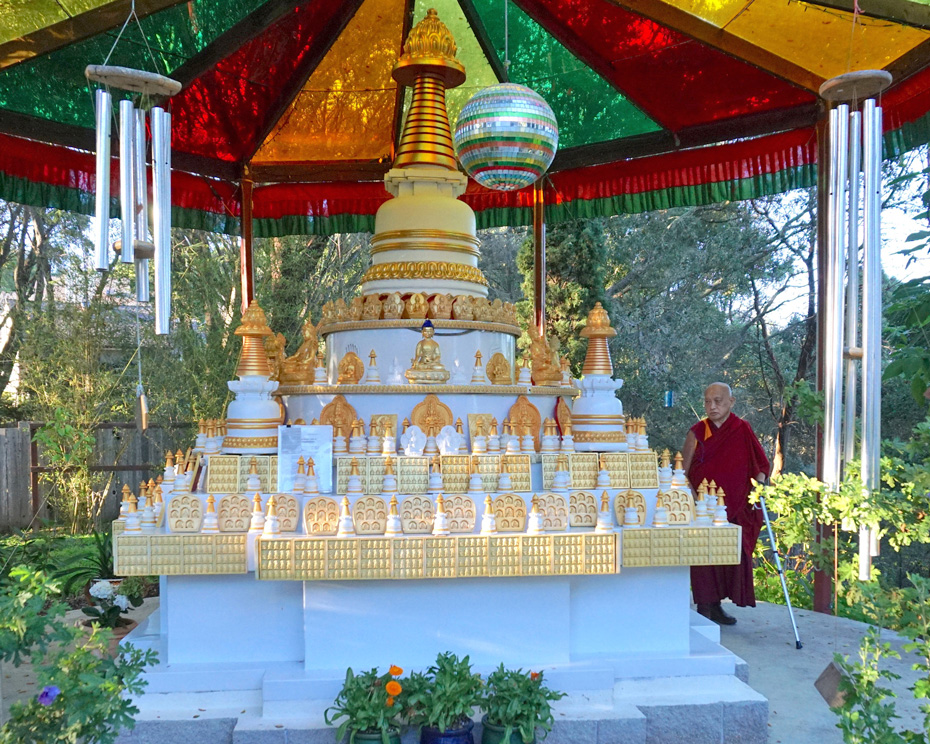
Lama Zopa Rinpoche circumambulating stupas and tsa-tsas at Kachoe Dechen Ling, Aptos, California, US, November 2016. Photo by Ven. Lobsang Sherab.
Lama Zopa Rinpoche gave this advice to a student who said they had a new stupa in their house.
My most dear, most kind, most precious, wish-fulfilling one,
As this stupa was filled at Amitabha Buddha Centre (ABC), then it will have the Four Dharmakaya Relic Mantras inside.
This is a Kadampa stupa, like what Lama Atisha used to carry, keeping the Guru’s hair, robes, and relics inside. When Atisha was on the road, even if a very subtle vice had been committed, he would immediately prostrate to the stupa and confess. This was how he used the stupa, for that purpose.
Here I want to say this: you don’t have to put this stupa on your altar. Many times people don’t even look at the altar. So here, it is so important to see the stupa. Each time you see it there is great, great purification and that brings you to enlightenment; this is just by looking at the stupa.
Therefore, it is better to put it in the kitchen or living room or on a table. If you have many stupas then you can put them on a table and also put other Buddha statues and texts (sutras such as the Vajra Cutter Sutra, Golden Light Sutra, Aryasangata Sutra, and so forth) then you can go around all these holy objects that are on the table. It makes it so easy to circumambulate them.
This is a great thing. It purifies negative karma collected from beginningless rebirths that are obstacles to happiness—temporary and ultimate happiness—and especially to actualizing all the realizations on the path to enlightenment. And it creates the cause to achieve the path to enlightenment—to actualize the teachings that you have heard and read in your heart.

Rinpoche circumambulating stupas and tsa-tsas at students’ home in North Darolina, August 2016. Photo by Ven. Roger Kunsang.
People who are non-believers can also go around the table with this stupa (and if you have them, other holy objects) on it while you are having a conversation with them. In this way even if your speech is non-virtuous, you can still collect unbelievable virtue with your body. And the non-believers also create the cause of enlightenment. There is great purification, and also one is able to collect merits.
It is like the example of Jinpa Palgye (Shrijata). This is a story from the sutras. A long time ago he was a fly who followed the smell of cow dung around a stupa. That action became the cause in his life—when he was eighty years old—to begin to practice Dharma. He achieved renunciation from samsara. And by becoming free from samsara, he achieved the level of Arhat, free from samsara and the causes of samsara—delusion and karma.
Not only non-believers, even when people from outside visit your house, they can also go around. If you have pets, such as dogs and cats, you can also bring them around the stupa that is on the table by holding them in your hands if you can, so they are at the same level as the stupa.
Also if you find worms, insects, or flies in the house, or ants on your body—basically any insect that you find—you can catch them and put them in a plastic bag. Here at ABC they kindly made these insect catchers, which are two small boxes. One is called “method,” and the other is called “wisdom.” So you can put the insect in those, then take them around the stupa a few times, and then release them in a safe place.
Or if you have a thousand ants or crickets in a plastic bag, then you can take them all around the stupa. This plants the seed of enlightenment in all their hearts, and there is great purification of heavy negative karma that has been collected from beginningless rebirths. Also they collect extensive merits.
This is the best present from your side that you can offer them, as they are the cause of all your happiness from beginningless rebirths until now and also in the future. Every single happiness you receive from them. Beside that, they have been kind to you from beginningless rebirths. They have created so much negative karma in order to take care of you. They have suffered unbelievably, unbelievably, unbelievably for you and will do so again in the future, until you are free from samsara.
Therefore, it is so important to be free from samsara as quickly as possible by actualizing wisdom directly perceiving emptiness. So for that you need calm abiding. For that you need pure morality, the three higher trainings, not only if you are ordained but also as a lay practitioner.
Having the Four Dharmakaya Relic Mantras inside the stupa means it also has the Secret Relic Mantra inside. So if you go around the stupa with this mantra inside just one time, it purifies all the heavy negative karmas to be born in the hot hells, down to the eighth hot hell, the unbearable hell realm that has the heaviest suffering. All this gets purified and it makes it so easy to be born in a pure land or to achieve a perfect human rebirth with the eight freedoms and ten endowments, so one has the freedom to practice Dharma and to achieve enlightenment.
When you go around the stupa you can recite OM MANI PADME HUM or other mantras, or if you have some commitments then you can recite them. Because if you sit down to pray then you go to sleep, but when you try to go to sleep, then you are fully awake, but not necessary fully awake in Dharma.
One time in Kachoe Dechen Ling in California, our very precious kind Fabrizio [Pallotti] was in the same area and he was talking to me a long time on the phone. I was in my room and in that room I have a table that has many stupas, prayer wheels, statues, texts, relics, and images of buddhas on it. The table is similar to the altar tables I have in my room in Kopan and also in Dharamsala. The table is round and quite high and has many holy objects on it at a few different levels. You can go around the table. So as I was on the phone I thought to make the time worthwhile while I was talking, so I went around the table with all the holy objects. In this way at least I can collect merit and purify the cause of the lower realms and create the cause to be free from samsara, and also lower nirvana and achieve great enlightenment. By going around the holy objects, at least with the body, one can create virtue and the cause of enlightenment.
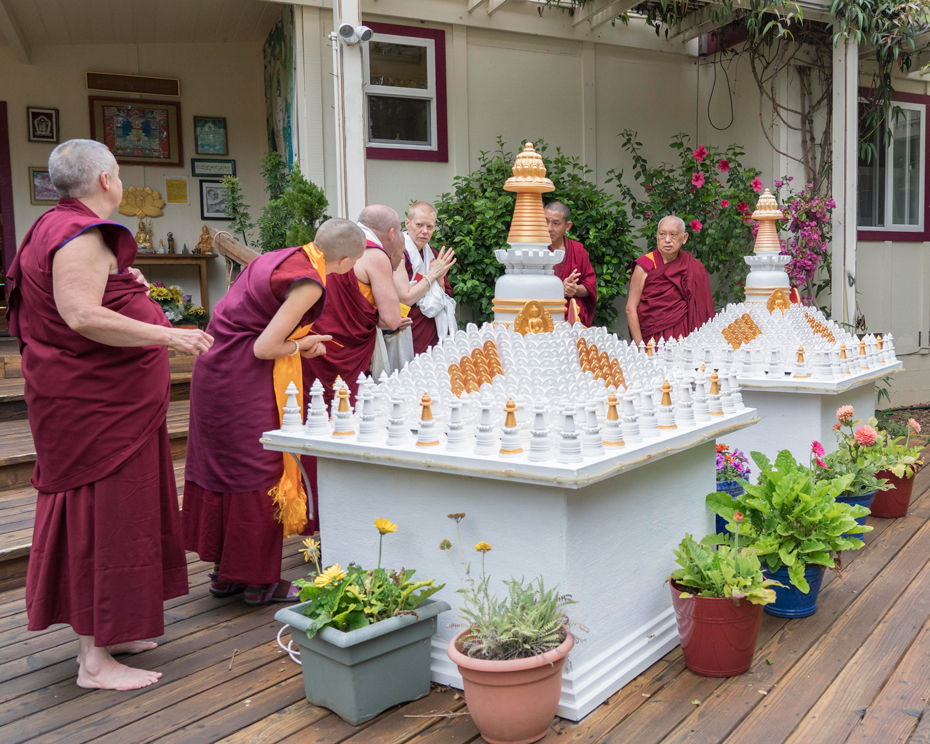
Rinpoche with Sangha next to stupas and tsa-tsas at Kachoe Dechen Ling, Aptos, California, US, August 2018. Photo by Ven. Lobsang Sherab.
Also outside the office at Kachoe Dechen Ling there is a table set up with many Kadampa stupas and tsa-tsas,and a bigger stupa in the center. It is very neatly set up. So while Roger [Kunsang] and Holly [Ansett] are talking on the phone, which happens a lot, then at least they can go around and make the action of the body virtuous and create the cause of enlightenment.
If you put this stupa on the dining room or living room table, it makes it very easy for people to go around every day, many people, so many times a day. It is so good to go around. So then you can rejoice at the end of the day, that at least there was some virtuous action collected. Then as many people spend a long time on the phone, while they are on the phone, they can go around the stupa. So it helps very much to not waste this most precious human rebirth.
You can look at some photos of how I have set up the different stupas at Kachoe Dechen Ling. Also there is one Vietnamese family in North Carolina who has made a thousand Buddha statues, and they made an altar for the statues with many different colored lights. They go around every day, and also even their children go around by themselves as well.
So because we have this perfect human rebirth—it is just one time, it is not sure how long we will have it, life is very short—I am suggesting this so as to not waste your most precious human life, which is more precious that the whole sky filled with wish-granting jewels, not only diamonds. Thank you very much.
With much love and prayers,
Lama Zopa
P.S. Please read and look at the stupas here:
https://fpmt.org/media/newsletters/archives/lama-zopa-rinpoche-news-december-2004/#4
Colophon: Scribed by Ven. Holly Ansett, Kachoe Dechen Ling, Aptos, California, US, October 14, 2015. Lightly edited by Laura Miller, March 2019.
For more on stupas and their benefits, see FPMT Education’s “Stupas: A Resource Guide”:
https://fpmt.org/education/practice/holy-objects/stupas-resources/
Find more advice from Lama Zopa Rinpoche:
https://fpmt.org/teachers/zopa/advice/
Lama Zopa Rinpoche is the spiritual director of the Foundation for the Preservation of Mahayana Tradition (FPMT), a Tibetan Buddhist organization dedicated to the transmission of the Mahayana Buddhist tradition and values worldwide through teaching, meditation and community service.
- Tagged: advice from lama zopa rinpoche, circumambulation, kachoe dechen ling, lama zopa rinpoche, stupas
25
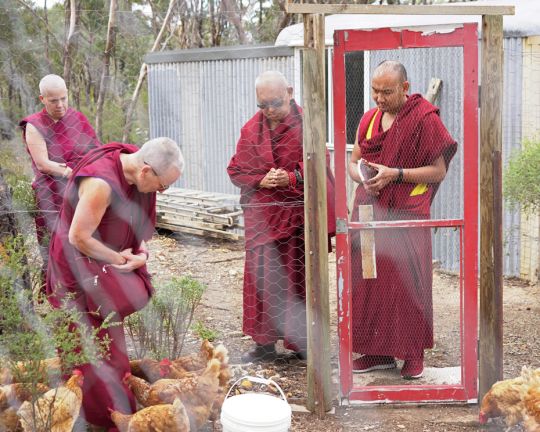
Lama Zopa Rinpoche blessing chickens at Thubten Shedrup Ling Monastery, Bendigo, Australia, April 2018. Photo by Ven. Lobsang Sherab.
During the 2018 retreat in Australia, Lama Zopa Rinpoche was asked, “What is the best way to develop bodhichitta?” You can read Rinpoche’s response in this excerpt from the teaching and in the following video clip.
Many people think there must be some other way to develop bodhichitta. There must be some other way, not lamrim. There must be something special. Not lamrim, not lamrim! Something fantastic! Some other way.
I say “renunciation.” My answer is “renunciation.” The more strongly you see your own suffering in samsara, then when you think of others, you have stronger compassion. You feel others’ suffering in samsara. Then also you have loving kindness for others. You want others to have happiness. And then you have stronger compassion for others to be free from samsara.
For one to do that by oneself—to free all sentient beings from samsara and bring to buddhahood—one has to achieve enlightenment. To do that by oneself alone, then one has to achieve enlightenment. So how strong one’s bodhichitta is depends on the foundation—strong renunciation, strong compassion. When they are strong, then there is strong bodhichitta.
In this southern continent there are all kinds of happiness, but there are all kinds of suffering. There is so much suffering that you can see, you can hear, so much in the world.
The other worlds are not like that. Like the northern continent where everybody lives for one thousand years, nobody is poor, everybody is unbelievably wealthy. Everybody lives for one thousand years. So like that it is very difficult to get renunciation of samsara, so difficult to achieve compassion and bodhichitta.
Here in this world it is much easier. You can see so much suffering. You can feel your own suffering of samsara more strongly. Then it is so easy to develop compassion and so easy to develop bodhichitta.
It is said in Tibetan that due to karma, strong karma, it is easy to generate strong bodhichitta. So we are incredibly fortunate to be born in this time in the southern continent. We are so fortunate because of that. That makes it easy to achieve enlightenment.
Watch Rinpoche teach on “The Best Way to Develop Bodhichitta”:
https://youtu.be/ofZX77L7vnY
Colophon: Excerpted from Lama Zopa Rinpoche’s teachings at the Great Stupa of Universal Compassion, Bendigo, Victoria, Australia, April 10, 2018. Simultaneously transcribed by Ven. Joan Nicell. Lightly edited by Laura Miller, March 2019.
Find complete videos of Lama Zopa Rinpoche’s recent teachings:
https://fpmt.org/media/streaming/teachings-of-lama-zopa-rinpoche/
Lama Zopa Rinpoche is the spiritual director of the Foundation for the Preservation of Mahayana Tradition (FPMT), a Tibetan Buddhist organization dedicated to the transmission of the Mahayana Buddhist tradition and values worldwide through teaching, meditation and community service.
- Tagged: bodhichitta, essential extract, lama zopa rinpoche, lamrim, practical advice, renunciation, video
22

Tsog offering during Lama Chopa, Tushita Meditation Centre, Dharamsala, India, September 2018. Photo by Simon Houlton.
Lama Zopa Rinpoche received a question from a student who was experiencing many obstacles to Dharma practice. In addition to doing the practice of the Thirty-Five Buddhas of Confession and Vajrasattva practice, Rinpoche advised doing mandala offerings:
… Yes, there are some people who have many obstacles when listening to teachings, and when they don’t meditate, then nothing happens. For some people it is like this, and it means there is an obstacle to practice.
It is also very good to do mandala offerings. The mandala offering is very important and at the end of Jorcho preliminary practice, when you make the mandala offering, make a request for the three great purposes.
SPECIAL REQUEST FOR THE THREE GREAT PURPOSES
I prostrate and go for refuge to the guru and the Three Rare Sublime Ones: please bless my mind.
Please bless me and all mother sentient beings to immediately cease all the wrong concepts from disrespect to the spiritual friend up to the subtle dual appearances of the white appearance, red increase, and dark near attainment.
Please bless us to immediately generate all the right realizations from respect for the spiritual friend up to the unification of no more learning.
Please bless us to immediately pacify all outer and inner obstacles. (3x)
The first request is to pacify all the wrong concepts up to subtle dual view of the white, red, and dark visions, next is to generate all the correct realizations from guru devotion up to enlightenment, and the third request is to pacify the outer and inner obstacles.
Outer obstacles are, for example, when you don’t have freedom and you are told by the king, the government or your parents to do something else, like go into the army or kill others, especially to engage in negative karma. Inner obstacles are diseases and also the delusions. Therefore, doing mandala offerings is very important in your life. Then dedicate the mandala. You have to visualize according to the commentary, that is best, and then you collect unbelievable, unbelievable merits, and you dedicate that merit to achieve these three things. That is very, very important, otherwise if you don’t do that, nothing changes.
You should think these obstacles are good and that they arise because of the benefits of practicing Dharma. Think you are experiencing the past karma now; that your past negative karma is finishing. That is a good thing, it is the benefit of practicing Dharma. It is a good thing.
It is very important if you can think that whatever problem you have, you are experiencing that problem for numberless sentient beings. You are experiencing all the suffering and the cause of the suffering—the delusions and karma—for sentient beings, so you receive that from them and then they achieve dharmakaya. This is unbelievable, unbelievable, most unbelievable purification and a quick way to achieve enlightenment. It’s a quick way to enlighten sentient beings, for them to achieve enlightenment. So mostly take the suffering.
Also give your body as a wish-granting jewel, as numberless, so make charity to all those six-realm sentient beings. Then give your possessions and all your past, present, and future merits to numberless sentient beings, so they receive all the happiness. They receive the happiness of this life and of future lives, and ultimate happiness, liberation from samsara, peerless happiness, enlightenment, so they receive everything. Then rejoice. When you give your body, possessions, and merits as a wish-granting jewel, then everything becomes wish-fulfilling for all the sentient beings. The main thing is that they achieve all that happiness, liberation, and enlightenment.
It is very good to do this as much as possible—taking other sentient beings’ sufferings and giving your happiness, your merits etc., to others. It is so good. Spend more time taking others’ sufferings, experiencing the suffering of others, the numberless sentient beings.
This can change your karma. It is a most unbelievable, most unbelievable way to collect merit and a quick way to achieve enlightenment for sentient beings. This is most powerful purification, and it can change your karma the more you do it.
Read Rinpoche’s complete advice “Purifying Obstacles to Dharma Practice,” posted on the Lama Yeshe Wisdom Archive website in January 2019:
https://www.lamayeshe.com/advice/purifying-obstacles-dharma-practice-0
The FPMT Foundation Store makes available the Lama Chopa Jorcho practice book and commentary by Lama Zopa Rinpoche on this heart practice:
https://shop.fpmt.org/search.asp?keyword=jorcho&search=
Lama Zopa Rinpoche is the spiritual director of the Foundation for the Preservation of Mahayana Tradition (FPMT), a Tibetan Buddhist organization dedicated to the transmission of the Mahayana Buddhist tradition and values worldwide through teaching, meditation and community service.
- Tagged: jorcho, lama chopa, lama zopa rinpoche, purification practice
- Home
- News/Media
- Study & Practice
- About FPMT Education Services
- Latest News
- Programs
- New to Buddhism?
- Buddhist Mind Science: Activating Your Potential
- Heart Advice for Death and Dying
- Discovering Buddhism
- Living in the Path
- Exploring Buddhism
- FPMT Basic Program
- FPMT Masters Program
- FPMT In-Depth Meditation Training
- Maitripa College
- Lotsawa Rinchen Zangpo Translator Program
- Universal Education for Compassion & Wisdom
- Online Learning Center
- Prayers & Practice Materials
- Overview of Prayers & Practices
- Full Catalogue of Prayers & Practice Materials
- Explore Popular Topics
- Benefiting Animals
- Chenrezig Resources
- Death & Dying Resources
- Lama Chopa (Guru Puja)
- Lama Zopa Rinpoche: Compendium of Precious Instructions
- Lama Zopa Rinpoche: Life Practice Advice
- Lama Zopa Rinpoche Practice Series
- Lamrim Resources
- Mantras
- Prayer Book Updates
- Purification Practices
- Sutras
- Thought Transformation (Lojong)
- Audio Materials
- Dharma Dates – Tibetan Calendar
- Translation Services
- Publishing Services
- Teachings and Advice
- Find Teachings and Advice
- Lama Zopa Rinpoche Advice Page
- Lama Zopa Rinpoche: Compendium of Precious Instructions
- Lama Zopa Rinpoche Video Teachings
- ༧སྐྱབས་རྗེ་བཟོད་པ་རིན་པོ་ཆེ་མཆོག་ནས་སྩལ་བའི་བཀའ་སློབ་བརྙན་འཕྲིན།
- Podcasts
- Lama Yeshe Wisdom Archive
- Buddhism FAQ
- Dharma for Young People
- Resources on Holy Objects
- Ways to Offer Support
- Centers
- Affiliates Area
- Teachers
- Projects
- Charitable Projects
- Make a Donation
- Applying for Grants
- News about Projects
- Other Projects within FPMT
- Support International Office
- Projects Photo Galleries
- Give Where Most Needed
- FPMT
- Shop
Translate*
*powered by Google TranslateTranslation of pages on fpmt.org is performed by Google Translate, a third party service which FPMT has no control over. The service provides automated computer translations that are only an approximation of the websites' original content. The translations should not be considered exact and only used as a rough guide.Whether one believes in a religion or not, and whether one believes in rebirth or not, there isn’t anyone who doesn’t appreciate kindness and compassion.







